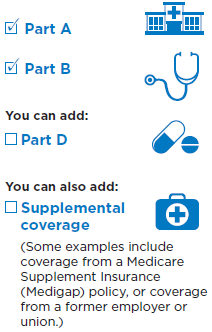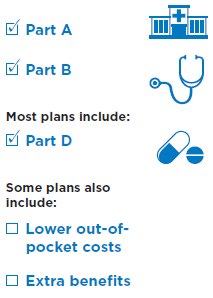Medicaid and CHIP (Children's Health Insurance Program) are joint federal and state public health insurance programs that cover roughly 1 in 5 Americans, including low-income families and individuals, children, parents, pregnant women, seniors, and some people with disabilities. In addition, it is the nation’s largest provider for long-term care coverage. For the majority of people enrolled, these programs are the only option for affordable health coverage, largely because it drastically limits an individual’s out-of-pocket costs.
Medicaid
Each state operates their own Medicaid program. While the federal government broadly defines the requirements and provides oversight, states have the flexibility in how they design and implement their programs. For example, a state can choose to offer additional services and extend the eligibility criteria. However, should a state choose to deviate from the federal regulations they must seek approval from the federal government. Collectively, these differences make each state’s Medicaid program different.
To receive federal funding, states must cover certain groups:
- Children up to 18 in families with income below 138% of the federal poverty limit (FPL). The FPL changes each year.
- People pregnant and with income below 138% FPL
- Certain parents or caregivers with very low income
- Most seniors and people with disabilities who receive cash assistance through the Supplemental Security Income (SSI) program
The ACA gave state’s the option to expand the populations they cover. Currently 39 states (including Washington, DC) have adopted the Medicaid expansion, while 12 states have not. In states that expanded, nearly all adults (i.e., childless adults) with incomes at or below 138% of poverty level now are eligible for Medicaid. This means there are no categorically excluded low-income individuals in states that expanded their programs.
Review the current status of Medicaid expansion in each state
The only way for you or your family to qualify is to meet your state’s specific eligibility requirements. Moreover, each state’s benefits are slightly different. So, if you recently moved to another state and your income hasn’t changed, it is critical to check if you still qualify and what benefits are included.
Get an overview of your state’s Medicaid program
(including eligibility requirements)
CHIP
Similar to Medicaid, CHIP provides health coverage to eligible children (up to age 19) either through Medicaid and/or a separate CHIP program. The program is an affordable way for kids get covered when the family’s income is too high for Medicaid but too low for affordable marketplace or other coverage. CHIP is a joint federal and state program that is administered by states, complying with federal requirements. States have broad flexibility to define their program and the services provided.
Get an overview of your state’s CHIP program
(including eligibility requirements)
Medicare
Medicare is federal health insurance program for people who are 65 or older and certain younger people with specific disabilities. It also covers people with end-stage renal disease (ESRD). To get Medicare you must be a U.S. citizen or lawfully present in the U.S. for five continuous years.
Parts of Medicare:
Part A (Hospital Insurance) helps cover:
- Inpatient care in hospitals
- Skilled nursing facility (SNF) care
- Hospice care
- Home health care
Most beneficiaries are enrolled in Part A automatically.
Part B (Medical Insurance) helps cover:
- Services from doctors and other health care providers
- Outpatient care
- Home health care
- Durable medical equipment (DME) (like wheelchairs, walkers, hospital beds, and other equipment and supplies)
- Clotting factor therapies
- Many preventive services (like screenings, shots, and yearly wellness visits) Most beneficiaries are enrolled in Part B automatically
Part C (also known as Medicare Advantage (MA))
- An “all-in-one” alternative to Original Medicare. These “bundled” plans include Part A, Part B, and usually Part D.
- May have lower out-of-pocket costs than Original Medicare.
- Plans may offer extra benefits that Original Medicare doesn’t cover—such as vision, hearing, dental, and more.
Part D (Prescription drug coverage):
- An optional benefit available to all people with Medicare
- Run by private companies that contract with Medicare and follow rules set by Medicare
- Provided through
- Medicare Prescription Drug Plans (PDPs) (work with Original Medicare)
- Medicare Advantage Prescription Drug Plans (MA-PDs)
- Some other Medicare health plans (like Cost Plans)
- Options
- Can add to Original Medicare
- Usually included in Medicare Advantage (MA)
Enrollment
When you first enroll in Medicare, and during certain times of the year, you can choose how you get your Medicare coverage. There are two main ways to get Medicare:
Original Medicare (Part A and B)

- Includes Medicare Part A (Hospital Insurance) and Part B (Medical Insurance)
- If you want drug coverage, you can join a separate Part D plan (note: everyone should consider getting a Part D plan)
- To help pay your out-of-pocket costs in Original Medicare (like your deductible and 20% coinsurance), you can also shop for and buy supplemental coverage
*Please note that Medicare Supplement Insurance (Medigap) policies only work with Original Medicare
Medicare Advantage (MA)

- An “all-in-one” alternative to Original Medicare. These “bundled” plans include Part A, Part B, and usually Part D.
- May have lower out-of-pocket costs than Original Medicare.
- Plans may offer extra benefits that Original Medicare doesn’t cover—such as vision, hearing, dental, and more.
Original Medicare vs. Medicare Advantage: Coverage
| Original Medicare | Medicare Advantage |
| Original Medicare covers medically necessary services and supplies in hospitals, doctors’ offices, and other healthcare settings. | Plans must cover all of the medically necessary services that Original Medicare covers. Most plans may offer extra benefits that Original Medicare doesn’t cover—such as vision, hearing, dental, and more. Plans can now cover more of these benefits than they have in the past. |
| You can join a separate Medicare Prescription Drug Plan (Part D) to get drug coverage. | Prescription drug coverage is included in most plans. |
| In most cases, you don’t have to get a service or supply approved ahead of time for it to be covered. | In some cases, you have to get a service or supply approved ahead of time for it to be covered by the plan. |
There are a variety of resources available to help you learn more and answer any questions, including:
- Medicare Website - Or call
- 1.800.MEDICARE (1.800.633.4227)
- TTY: 1.877.486.2048
- Medicaid Website
- Social Security Website - You can call your local Social Security office.
- Health Insurance Marketplace Website
- Children’s Health Insurance Program website
- CMS National Training Program
- SHIPs - You can contact your local SHIP office

